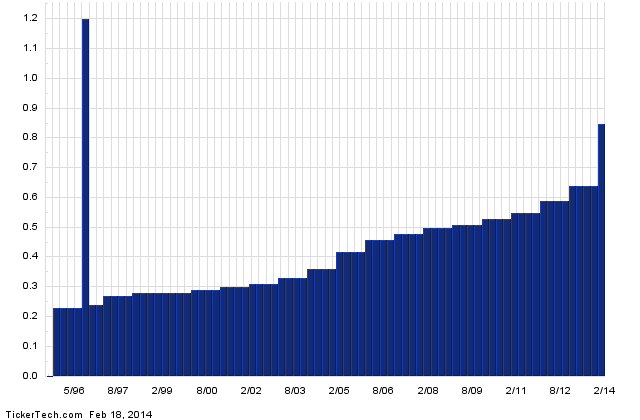Play It Safe with These 4 Dividend ETFs
Post on: 11 Июль, 2015 No Comment

A discussion about dividends used to revolve solely around stocks. Not anymore. The evolution of the exchange-traded products business has been a boon to income investors. Dozens of exchange-traded funds (ETFs ) now fit into the » Dividend ETF » classification..
And perhaps more important in today’s market environment is the stability dividend-paying stocks and ETFs afford investors. Add it all up, and it’s a great time to be a dividend investor.
Here are three dividend ETFs to help get you started.
1. Vanguard Dividend Appreciation ETF (NYSE: VIG )
The dividend yield on VIG isn’t jaw-dropping. It’s only 2.4%. But there are reasons to embrace this large-cap fund. In typical Vanguard fashion, VIG undercuts scores of its rivals with a tiny expense ratio. In this case, we’re talking about 0.18%. This is lower than 84% of comparable ETFs, according to Vanguard.
Consumer staples and energy stocks combine for more than 45% of VIG’s weight. This may seem high, but this ETF should be applauded for what it does NOT have, namely, large exposure to financials, which account for just 6.3% of VIG’s sector allocation. VIG is a solid way to play a large group of blue-chip stocks with some of the longest streaks of dividend increases out there. Coca-Cola (NYSE: KO ) and Procter & Gamble (NYSE: PG ). just to name a pair, call this ETF home.
2. Guggenheim Multi-Asset Income ETF (NYSE: CVY )
The dividend discussion should not be limited to common stocks. CVY reminds investors of this by featuring a mix of common stocks, foreign stocks, master-limited partnerships (MLPs), real estate investment trusts (REITs), royalty trusts, preferred stocks and closed-end funds. It’s almost like Christmas for the investor looking to diversify beyond the usual dividend fare.
CVY’s expense ratio of 0.6% is on the high side in the dividend ETF universe. Of course, a yield of 5% can help you forget about that pretty quickly. Energy, financials and utilities comprise roughly two-thirds of CVY’s sector allocation.
3. Global X SuperDividend ETF (NYSE: SDIV )
It’s always up for debate how »super» any ETF is, but SDIV is certainly unique. One hundred stocks are found in this new ETF, with each getting a weight of 1%. Despite bad timing with its debut (SDIV started trading in early June), the ETF has raked in $30.6 million in assets. This is an impressive haul for just four months of trading.

U.S. stocks account for almost a third of the ETF’s weight, but developed markets such as Australia and the U.K. also figure prominently in the mix. With a yield near 5.6%, SDIV is heavy on familiar dividend sectors such as REITs, telecom and utilities.
For those who love investing in emerging markets, DGS is the epitome of an ETF you want to love, but just can’t right now. You want to love it for the alluring combination of dividends, emerging markets and small-caps all wrapped in one fund. But you can’t afford to pull the trigger, because most emerging markets and small-caps simply aren’t working right now.
That much is highlighted by DGS’ chart, which is flat-out ugly. This was a $56 ETF in May. Today, it hovers around $43 with a yield of 6.26%. One important quibble with this ETF: Indonesia has been one of the best-performing markets year-to-date. DGS only allocates 1.96% to that country.
Five sectors (financials, industrials, consumer discretionary, information technology and materials) get double-digit weights in this ETF. Investors should note two DGS’ top-10 holdings are other WisdomTree ETFs. The bottom line with DGS is it has the potential to be an a solid bet. It has been in the past. The ETF just needs a cooperative market environment to merit a »buy» recommendation.
Risks to Consider: The biggest risk to any of these ETFs and the dividend universe at large is that the Federal Reserve shocks the world and raises interest rates. This would make fixed-income investments such as bonds more attractive, but higher rates aren’t likely in the near-term. DGS is the most speculative of the group, due to the emerging-markets/small-cap combination. VIG’s allocations to economically sensitive companies will be an issue as long as U.S. economic growth remains slack.
Action to Take—> Even with the aforementioned risks, VIG is the best bet here for the most conservative investors. With interest rates likely to stay low for a while, CVY’s exposure to interest rate-sensitive securities could be a help to the ETF. It’s my preferred option for aggressive investors right now.














